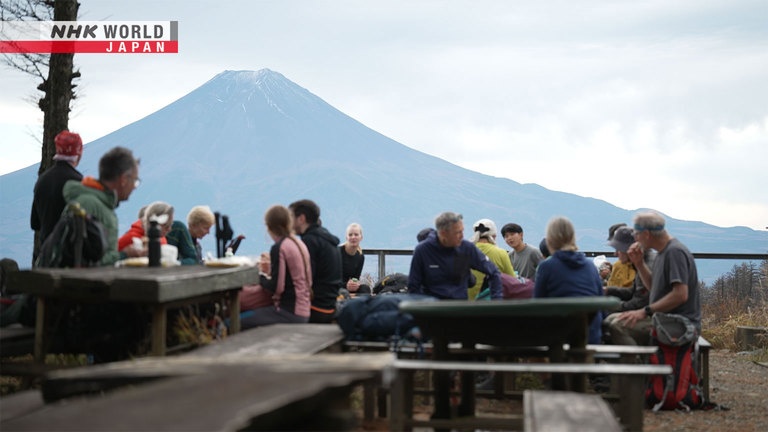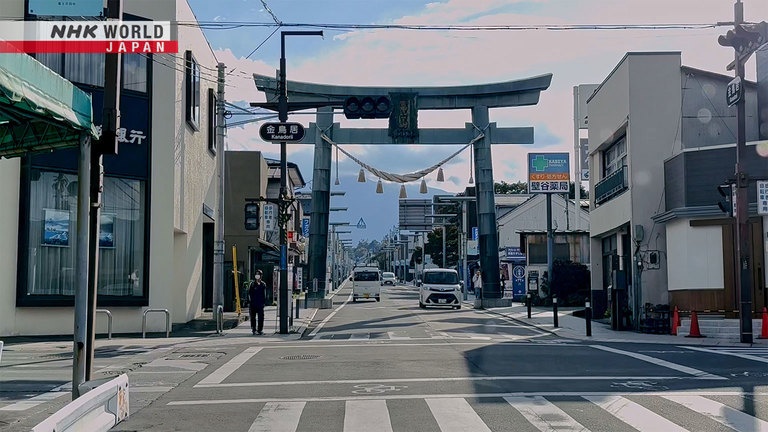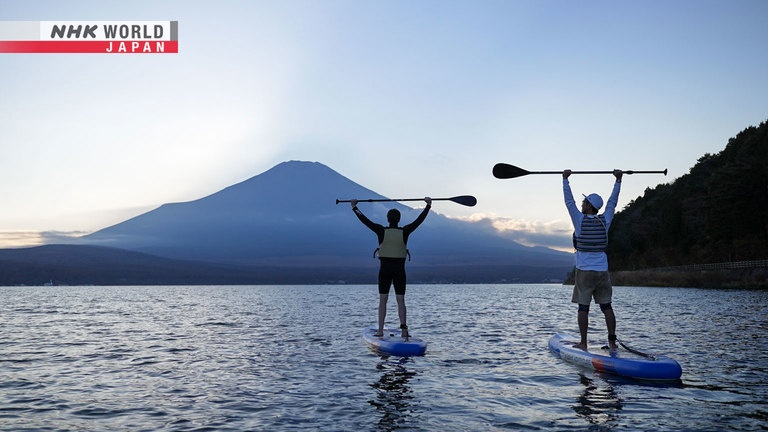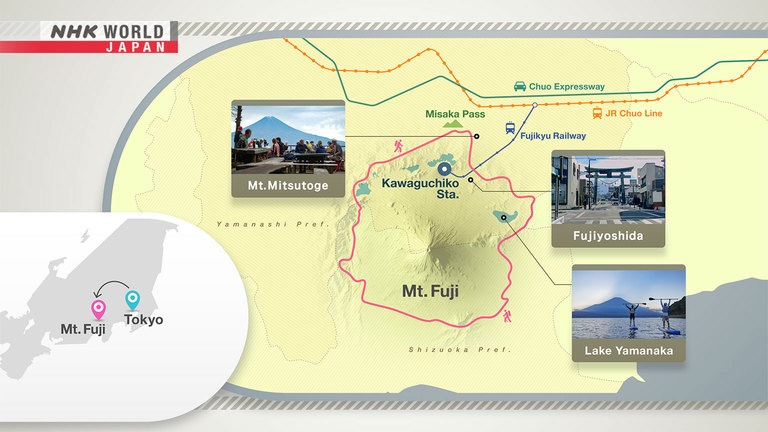360 Degrees of Mt. Fuji: Hiking the Long Trail - Part 1
In 2021, a long trail course was established that encircles Mt. Fuji. By following this trail, one can explore not only the natural beauty but also the profound allure of Mt. Fuji, which has been a source of local history, culture, ancient beliefs and artistic inspiration for centuries. Kyle Card, a Canadian actor who previously completed the Tohoku Trail, now journeys around Mt. Fuji during the breathtaking transition from autumn to winter.
Mt. Mitsutoge

There is a mountain lodge, located at Mt. Mitsutoge, established about 70 years ago boasts the best location with a frontal view of Mt. Fuji. Due to this prime location, it attracts numerous hikers, photographers and rock climbers who come seeking the changing views of Mt. Fuji and the surrounding nature throughout the seasons.
Fujiyoshida City

During the Edo period, this town flourished as the gateway to Mt. Fuji. Accommodations provided by "Oshi" who supported the ascetic practitioners of Mt. Fuji, still exist in a few places today. The town is also famous for its weaving and local dish, Yoshida Udon noodle.
Lake Yamanaka

Located at the foot of Mt. Fuji, this lake boasts the largest surface area among the five lakes and is the closest to Mt. Fuji in terms of linear distance. Visitors can enjoy various activities such as canoeing, boating and stand-up paddleboarding (SUP).
Access

It takes about 3 hours from Tokyo by train and bus to the starting point, the Misaka Pass. Or 1.5-hour trip by car.
Transcript
"Journeys in Japan"
Fuji-san. Mt. Fuji.
These days, it's possible to hike all around this iconic peak.
The route is called the Mt. Fuji Long Trail.
Kyle Card is an actor who hails from Canada.
Interesting.
What a splendid house.
It looks wonderful. Look at that. Oh, that volume!
Mt. Fuji is so beautiful!
Kyle has set out to cover the entire trail,
a quest so long it will cover two editions of "Journeys in Japan."
In this episode, he'll be hiking along the east side of Mt. Fuji.
360 Degrees of Mt.Fuji
Hiking The Long Trail Part I
Mt. Fuji lies 100 kilometers to the west of Tokyo,
straddling the border between Yamanashi and Shizuoka prefectures.
The Mt. Fuji Long Trail was set up in 2021.
In all, it's 170 kilometers long.
Kyle plans to follow the trail clockwise
starting from Misaka Pass to the northeast of the peak.
Hello everyone. My name is Kyle Card,
and I am in the northern region of Yamanashi Prefecture,
currently in the Misaka mountain pass.
And today I'm traveling along a very special trail that circles all around
Mt. Fuji.
Before setting out, Kyle meets up with the man who created the trail.
Nice to meet you. Mt. Fuji is looking really beautiful.
When the weather is so good, it always looks good.
- We're very blessed.
- Really lucky.
What is the special appeal of this trail?
It has various different aspects. But, most of all, it's the beauty of Mt. Fuji.
When you climb it, you're too close to see its beauty.
But walking around it, you can enjoy it from a distance.
From here, it looks quiet and majestic.
But when you get further south, you see the huge crater halfway up its slope.
That shows the wilder, more dynamic side of Mt. Fuji.
Also, Mt. Fuji used to be worshiped as a deity.
A major appeal is you get to feel that history.
I'm looking forward to seeing its various faces.
It's going to be a long journey, Kyle. I wish you the best of luck!
Thank you.
Kyle has arrived at a lodge on Mt. Mitsutoge.
Hello. You must be Kyle. Welcome to Mitsutoge Lodge.
Good to meet you.
Nakamura Mitsuyoshi is the owner.
He's also a painter and photographer.
You have a nice lodge.
Thanks.
When was it built?
Over 70 years ago.
My father built it after World War II. Later, I took over running it.
Nakamura's father was also a photographer.
He fell in love with the view of Mt. Fuji from this spot,
and built this lodge soon after World War II.
What kind of people come to stay here?
These days, there are many kinds of people.
But for a long time, it was mostly photographers.
That is because my father was a photographer.
Do they come to take photos of Mt. Fuji?
Of course.
Mt. Fuji looks so beautiful from here.
You've never seen this view before?
I don't think so. I've never been here before.
A famous artist painted Mt. Fuji from this angle.
A very famous "ukiyoe" print that is well known abroad.
Could it be Hokusai?
Right. Hokusai.
"Red Fuji."
One of the classic prints by Katsushika Hokusai,
Japan's best-loved ukiyoe artist.
(Red Fuji 'South Wind, Clear Sky'
Katsushika Hokusai)
My father took a photo that looked really similar.
Not just the composition, also the snow on the peak.
It shows that Hokusai depicted Fuji from Mt. Mitsutoge.
You can feel the history here.
For hundreds of years people have come to this place where we're standing now.
That's very powerful.
Hokusai was not the only one captivated by Mt. Fuji.
Numerous artists have incorporated the famous peak as a motif in their works.
They're kind of wrestling in the hills.
(Kawaguchi Asama Shrine)
Excuse me,
can you tell me why there are so many shrines
and "torii" gateways around here?
The shrines are all dedicated to Mt. Fuji.
Come inside for some tea and we can chat about it.
I would love to.
Itadakimasu.
- That has warmed me up nicely.
- Good.
Once again, can you tell me why there are
so many shrines and torii gateways around here?
Across Japan, there are about 1,300 shrines dedicated to Mt. Fuji.
Why so many?
As you see, Mt. Fuji has its beauty. And it also brings us blessings.
But sometimes it causes catastrophes.
From that feeling of both fear and awe, it came to be worshiped as a deity.
Every region has shrines dedicated to Mt. Fuji.
I'm setting off to walk around Mt. Fuji.
Tell me, what is the best way to look at it?
People in this area think the best view of Mt. Fuji
is the one they can see from where they live.
I hope that as you walk, you'll find your own Mt. Fuji.
You're saying I should look for my own Mt. Fuji...
That's something I will look forward to.
For centuries, Mt. Fuji was revered from a distance.
But for pilgrims and mountain ascetics,
climbing the sacred peak became a key focus for their devotion.
From the 17th century, a network of roads was laid out across central Japan.
This led to a boom in travel,
and lodging towns sprang up to cater to those aiming to climb Mt. Fuji.
People would make their way from across Japan,
often carrying special "nobori" banners.
From this time on, Mt. Fuji became crowded with climbers.
Fujiyoshida has long been a starting point for the ascent of Mt. Fuji.
It still has traditional lodgings dating from that time.
Welcome to Fujiyoshida. Please come in.
Thank you. What a splendid house.
Thank you.
This house must have a long history.
It's about 450 years old.
So this is a lodging house?
It is an "oshi" priest's house.
Oshi were shamanistic priests.
In Fujiyoshida, they not only prayed
for the happiness and safety of the pilgrims,
they arranged their meals and lodging.
Ooganmaru is the 18th generation of his family to cater to the climbers,
going way back to the Edo period.
Did your ancestors dress like this when they prayed?
Yes.
In the old days, people came to purify themselves
in both body and spirit before climbing Mt. Fuji.
So, before setting off to climb they would first
spend the night at an oshi house.
This is how the town looked about 100 years ago.
You can see a large torii gateway in the corner.
Yes, I saw that.
This torii marks the entrance point for Mt. Fuji.
The area inside the torii is sacred.
In the Edo period, as many as 86 oshi houses
lined the streets here over a distance of 1 km.
If there were so many oshi houses,
that means huge numbers of people came to climb Mt. Fuji.
I've been told the houses were overflowing with visitors.
During the Edo period, so many people wished to be reborn,
in both body and spirit.
It was widely believed that by climbing Mt. Fuji you would be reborn.
It was a way for people to seek happiness.
I see.
Things haven't changed much since then, I think.
Mt. Fuji remains a powerful object of our admiration.
There will always be people climbing Mt. Fuji.
Even nowadays, when you climb the mountain you will feel something.
I think that is its charm.
Whether you feel reborn or just happiness, you do feel something.
That hasn't changed.
That's right.
I'll keep that in mind as I gaze at Mt. Fuji.
I hope you do that.
There's one dish that's been popular for centuries
for those climbing Mt. Fuji.
Sorry to keep you waiting.
It looks wonderful. Look at that. Oh, that volume!
Itadakimasu.
Oh, those look hot. Get a few less. Okay, here we go.
It's like a super dense al dente. It's really... Wow.
Very dense and very chewy!
This tastes really good. But the noodles are very chewy.
Yoshida "udon" noodles are famous for being hard.
Fujiyoshida was renowned as a weaving town.
The women used to weave, so the men cooked the food.
They kneaded the dough with all their strength.
That's how the udon became so firm and chewy.
You certainly have very sturdy arms.
It was customary for those climbing Mt. Fuji to wear white clothing.
They also used to eat food that was white.
Udon noodles are also white, so they're auspicious.
They certainly look like they'll give me strength.
I'm going to eat a whole lot of them!
This is so chewy. It just really gives the jaw a workout.
The village of Oshino lies 940 meters above sea level.
It was once a pilgrimage site for people worshiping Mt. Fuji.
Now it's a popular tourist spot.
The water seems to gush out everywhere.
This is snowmelt from Mt. Fuji
that has seeped down slowly underground over several decades.
To the south of Oshino Village lies Yamanakako.
This is the largest of the lakes at the foot of Mt. Fuji.
Hello.
Hello. I've been expecting you.
Welcome to Lake Yamanaka.
Such a wonderful place.
The lake is very calm today.
This feels so good.
And it's so beautiful here.
It's such a luxury to see this view every day.
It really is.
Look at that.
That's so beautiful.
It's incredible!
Yamanakako is the lake that lies closest to Mt. Fuji.
So you can really feel how big it is.
I'd say the view of Mt. Fuji from here is the very finest.
It's overwhelming!
It looks like a group of hunters.
Hello. Tell me, are you all hunters?
Yes, we are.
We just got back from hunting. Would you like to join us?
Interesting.
How long have you been hunters?
About 60 years.
I'm the 4th generation of my family to be a hunter.
For me, 47 years.
Originally, we hunted so we could feed our community.
We'd shoot pheasants, copper pheasants and hares.
We gave thanks for this abundance from the mountain
and we shared it with our community. Nothing was wasted.
Of course I love the mountains. I also love hunting.
But more than anything, I continue to hunt
because I strongly want to protect Mt. Fuji and its nature.
The hunters' mission, as authorized by the government, is to cull the deer.
The deer population has increased so much,
they're causing serious damage to the forests.
If there are too many deer, the nature here will be destroyed.
So hunting is essential to maintain the equilibrium.
It must take a lot of hard work to protect nature.
(Mizugatsuka Park)
This massive crater was left
following a huge volcanic eruption about 300 years ago.
Ash from the eruption carried 100 kilometers,
falling as far away as Edo, modern-day Tokyo.
I never expected to witness so many beautiful faces of Mt. Fuji
and learn that it possesses so much depth of culture and history.
But I'm still only half way through my journey,
and there's so much more for me to see and discover
along the Mt. Fuji Long Trail.
The journey continues.
In the next episode, Kyle will be exploring more of this remarkable trail
on the west side of Mt. Fuji.
From Tokyo, it takes about three hours by train and bus
to reach the starting point at Misaka Pass.
By car, it takes an hour and a half.